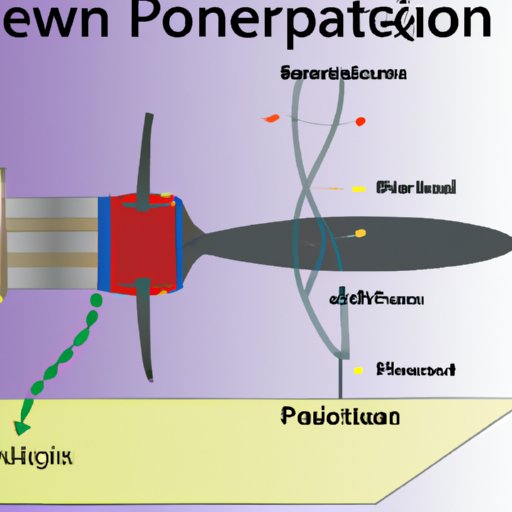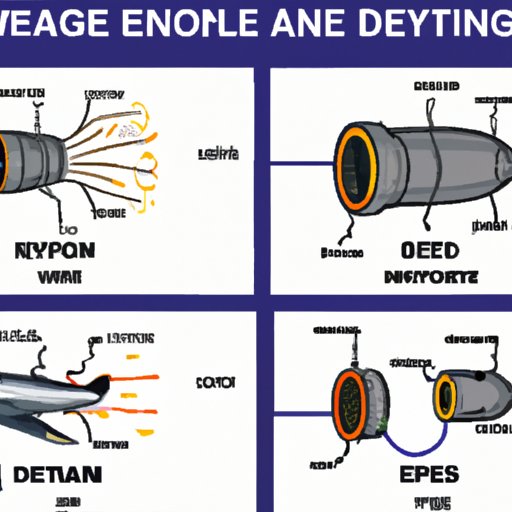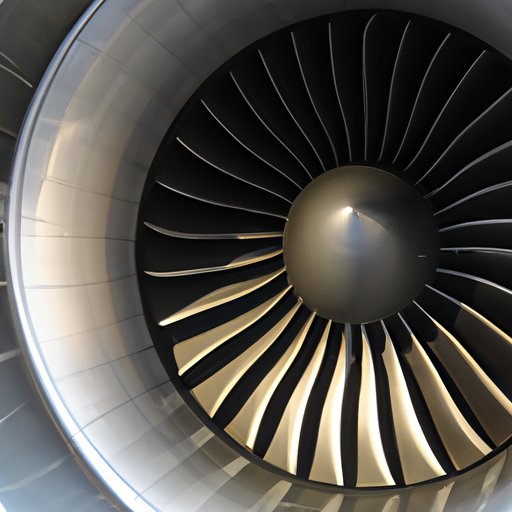Introduction
A jet engine is a type of propulsion system used in aircrafts. It is responsible for producing thrust by accelerating a high-speed jet of gas through a nozzle. The high-speed jet of gas produced is what propels the aircraft forward. Jet engines have been around since the early 1900s, but have seen significant advances in technology over the years. This article will provide an overview of how a jet engine works, including its components, working principles, physics, and fuel systems.
Explaining the Different Components of a Jet Engine
The main components of a jet engine are the turbine blades, compressor, combustion chamber, turbine, and exhaust nozzle. Each component plays an important role in propelling the aircraft forward.
Turbine Blades
The turbine blades are responsible for driving the compressor and turbine. They are typically made from stainless steel and are designed to be lightweight yet durable. As air passes through the blades, they spin, which then drives the other components of the engine.
Compressor
The compressor is responsible for compressing air before it enters the combustion chamber. This increases the pressure and temperature of the air, making it more combustible. The compressor is driven by the turbine blades and is typically made from aluminum alloys.
Combustion Chamber
The combustion chamber is where the fuel and air mixture is combusted. This process releases energy which is then used to drive the turbine blades. The combustion chamber is typically made from nickel alloys and is designed to withstand high temperatures and pressures.
Turbine
The turbine is responsible for driving the compressor and turbine blades. It is powered by the energy released during combustion and is typically made from stainless steel. The turbine is designed to be lightweight yet durable.
Exhaust Nozzle
The exhaust nozzle is responsible for directing the hot gases produced by combustion out of the engine. The exhaust nozzle is typically made from titanium and is designed to be lightweight yet durable.
Describing the Working Principles of a Jet Engine
Jet engines work by taking in air, compressing it, injecting fuel, combusting it, expanding the gases, and finally exhausting them. Each step is essential for the jet engine to function properly.
Intake of Air
The first step in the process is the intake of air. Air is drawn into the engine via an inlet duct. The inlet duct is designed to reduce drag and increase efficiency. The air is then compressed by the compressor.
Compression of Air
The compressor is responsible for compressing the air before it enters the combustion chamber. This increases the pressure and temperature of the air, making it more combustible. The compressor is driven by the turbine blades.
Fuel Injection
Once the air has been compressed, fuel is injected into the combustion chamber. This fuel is typically kerosene or jet fuel, but can also be other types of fuel. The fuel is injected at a precise rate to ensure the correct amount of fuel is combusted.
Combustion
Once the fuel has been injected, it is combusted in the combustion chamber. This process releases energy which is then used to drive the turbine blades. The combustion process is carefully controlled to ensure maximum efficiency.
Expansion of Gases
The hot gases produced by combustion are then directed out of the engine via the exhaust nozzle. As the gases pass through the nozzle, they expand and accelerate, producing thrust.
Exhaust
The exhaust gases are then expelled from the engine and produce thrust, propelling the aircraft forward. The exhaust gases are typically hot and contain unburnt fuel, water vapor, and carbon dioxide.

Outlining the Physics Behind Jet Propulsion
The physics behind jet propulsion are based on three principles: Newton’s third law, conservation of momentum, and Bernoulli’s principle. These principles explain how a jet engine produces thrust.
Newton’s Third Law
According to Newton’s third law of motion, for every action there is an equal and opposite reaction. This means that when the hot gases are expelled from the engine, they push against the atmosphere, creating an equal and opposite reaction, which produces thrust.
Conservation of Momentum
The conservation of momentum states that the total momentum of a system remains constant. This means that as the hot gases are expelled from the engine, the momentum of the aircraft increases, resulting in the aircraft moving forward.
Bernoulli’s Principle
Bernoulli’s principle states that as the speed of a fluid increases, its pressure decreases. This means that as the hot gases are expelled from the engine, their pressure decreases, resulting in a decrease in the amount of air resistance. This decrease in air resistance results in an increase in thrust.

Illustrating the Fuel System of a Jet Engine
In order for a jet engine to operate, it needs a source of fuel. There are several different types of fuel that can be used in a jet engine, such as kerosene, jet fuel, and diesel. The fuel is stored in tanks onboard the aircraft and is delivered to the engine via a fuel delivery system.
Types of Fuel
Jet engines can use several different types of fuel, such as kerosene, jet fuel, and diesel. Kerosene is the most common type of fuel used in jet engines, but other fuels can also be used depending on the application.
Fuel Storage
The fuel is stored in tanks onboard the aircraft. The tanks are designed to be light yet durable and are capable of storing large amounts of fuel. The tanks are pressurized to ensure the fuel is delivered to the engine at the correct pressure.
Fuel Delivery
The fuel is delivered to the engine via a fuel delivery system. This system consists of pumps, filters, valves, and injectors. The system is designed to deliver the fuel to the engine at the correct pressure and flow rate.

Comparing How Jet Engines Work to Other Types of Engines
Jet engines are similar to other types of engines, such as piston engines, turboprop engines, and turboshaft engines. However, there are some key differences between them.
Piston Engines
Piston engines are the most common type of engine used in aircrafts. They work by using a series of pistons to compress and ignite fuel and air. The resulting combustion then forces the pistons down, which drives the crankshaft and produces thrust. Piston engines are less efficient than jet engines, but they are cheaper and simpler to maintain.
Turboprop Engines
Turboprop engines are similar to jet engines, but instead of producing thrust directly, they use a propeller to produce thrust. The engine works by using a turbine to drive a propeller, which then produces thrust. Turboprop engines are more efficient than piston engines, but less efficient than jet engines.
Turboshaft Engines
Turboshaft engines are similar to jet engines, but instead of producing thrust directly, they use a shaft to produce thrust. The engine works by using a turbine to drive a shaft, which then produces thrust. Turboshaft engines are more efficient than piston engines, but less efficient than jet engines.
Examining the History of Jet Engines and Their Development
Jet engines have been around since the early 1900s and have seen significant advances in technology over the years. This section will examine the history of jet engines and their development.
Early Experiments
The earliest experiments with jet engines began in the early 1900s. These experiments focused on developing engines that could produce thrust without the use of propellers. Several different types of engines were tested, including ramjets, pulsejets, and turbojets.
Progress Through World War II
“During World War II, jet engines saw significant advances in technology. The German Luftwaffe was the first to develop a practical jet engine, the Junkers Jumo 004. This engine was used in the Messerschmitt Me 262, the first operational jet fighter. The Allies soon followed suit and developed their own jet engines, such as the Rolls Royce Nene and the General Electric I-16.” 1
Modern Jet Engines
Today, modern jet engines are much more efficient than their predecessors. Advances in technology have resulted in engines that are smaller, lighter, and more powerful. These engines are capable of producing more thrust while consuming less fuel.
Conclusion
This article provided an overview of how a jet engine works, including its components, working principles, physics, and fuel systems. It also examined how jet engines compare to other types of engines and discussed the history of jet engines and their development. Jet engines are complex and fascinating pieces of machinery that have revolutionized air travel. Understanding how they work is essential for anyone interested in aviation.
1 https://www.grc.nasa.gov/www/k-12/airplane/jetengin.
(Note: Is this article not meeting your expectations? Do you have knowledge or insights to share? Unlock new opportunities and expand your reach by joining our authors team. Click Registration to join us and share your expertise with our readers.)
